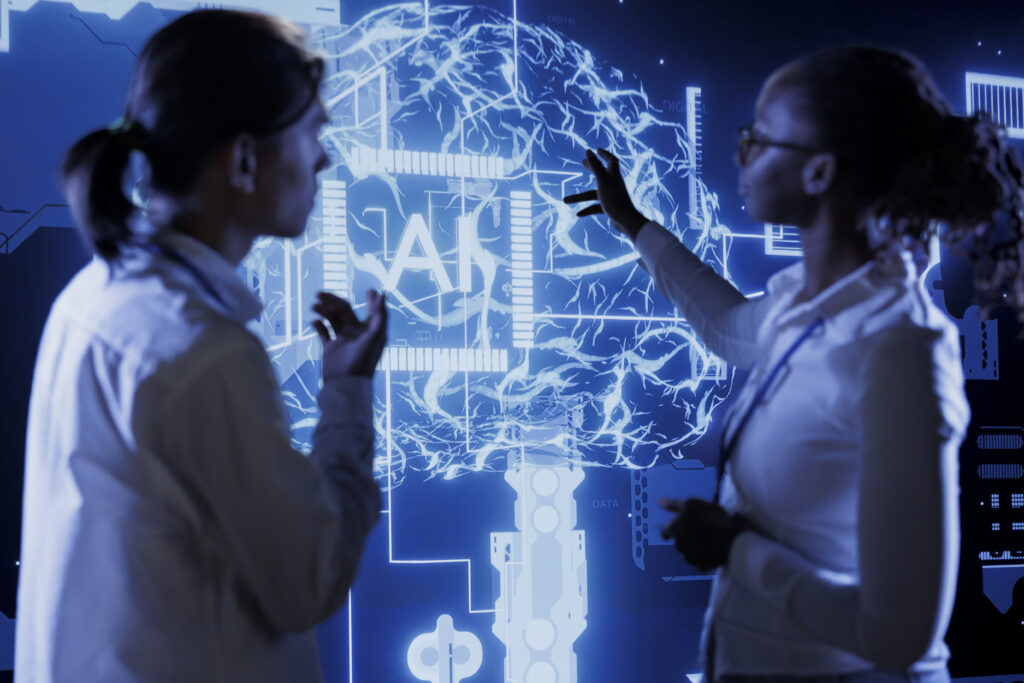Introduction
Imagine a time when you open your favourite app, and it recommends videos for you to watch. Or, if you wear a smartwatch that tracks your heart, the watch suggests other heart-healthy habits for you to consider. How did that technology become available to you? That’s the result of two powerful fields called Hybrid AI + Data Science.
Artificial Intelligence (AI): This is a field in which computers begin to think on their own. Basically, computers can learn, decide, and solve problems similar to the functions of a brain.
Data Science: The study of information (data). We take an enormous amount of data, analyse it, look for patterns, and then use the information to try to answer questions.
Now, imagine the brain power of AI combined with the data detective skills of Data Science. This combination, known as Hybrid AI + Data Science, is becoming the next big trend.

What is Hybrid AI?
Hybrid AI refers to the integration of different AI approaches, combined with data science, to create smarter, more efficient, and reliable systems.
Imagine it like this:
- A single AI is like a superhero with one great power, such as super speed or super strength.
- A hybrid AI combines many superpowers: speed, strength, flying, and invisibility, all working together with the guidance of data science.
Hybrid AI usually mixes two main types of AI:
- Machine Learning (ML): AI learns from data, like a student studying math problems.
- Rules-Based AI: AI follows human-made rules, like “if the traffic light is red, stop.”
When these come together, we get balance. The system learns from data but also respects rules that make sense in real life.
Example:
Picture an AI doctor. Machine Learning trains it by studying millions of medical records to understand how diseases develop and behave. Rules-based AI ensures it follows medical guidelines so it doesn’t make unsafe decisions. Together, they form a hybrid AI smart and safe.
Why It’s the Next Big Trend
So why is everyone talking about Hybrid AI and data science becoming the future? Let’s break it down.
More Reliable Decisions
- AI alone sometimes makes mistakes. Adding rules and human guidance makes it more trustworthy.
Better Handling of Complex Problems
- Life is messy and data is not always clear. Hybrid systems can use AI’s learning plus human-like logic to manage tricky situations better.
Faster Insights from Big Data
- Data Science brings the raw information, and Hybrid AI processes it faster, saving time in industries like healthcare and banking.
Safer Technology
- With rules plus learning, Hybrid AI decreases risks. For example, a self-driving car won’t just “guess,” it will also follow traffic laws.
Adaptable and Flexible
- Hybrid AI can adjust to new situations more easily because it doesn’t rely on just data or just rules, but both.
Business Benefits
- Companies can save money, avoid mistakes, and increase profits by combining these strengths.
Hybrid AI is powerful because it mixes the creativity of AI with the careful structure of rules and the insights of data science.
Impacts on Everyday Life
Hybrid AI isn’t just a fancy term for big companies. It’s already creeping into daily life and will shape the future in amazing ways.
Healthcare
- Hybrid AI tools might check medical scans for diseases but also balance medical guidelines, helping doctors make safer choices.
- Example: A smartwatch alerting you about heart issues before they get worse.
Education
- Schools could use hybrid AI to create personal lesson plans. If a student is good at math but struggles in science, the system could mix AI learning with teacher-guided rules to provide extra science practice.
Smart Homes
- Hybrid AI in home assistants (like Alexa or Google Home) could learn your habits (when you like your lights dimmed) while following safety rules (not turning on a heater for too long).
Travel and Cars
- Hybrid AI supports self-driving cars by combining AI learning from millions of routes with strict road-safety rules.
- Example: The car can guess when a pedestrian might cross the road, but it also always stops if the traffic light turns red.
Entertainment
- Streaming services will improve movie suggestions by using both learning (what you usually watch) and logic rules (not recommending children’s cartoons to adults unless requested).
Fighting Climate Change
- Hybrid AI can analyze huge sets of climate data while also following scientific models to suggest safe, eco-friendly actions.
Challenges and Opportunities
Every new technology has strengths and hurdles. Let’s highlight the two sides of Hybrid AI + Data Science.
Opportunities
- More Trustworthy AI: People are more likely to trust machines when they know rules are being followed alongside smart learning.
- Improved Healthcare: Doctors can save lives with faster, more accurate hybrid AI systems.
- Better Business Predictions: Companies can make decisions that are both data-driven and sensible.
- Wider Use: Education, farming, energy, and even entertainment will benefit.
- Jobs of the Future: Careers like “Hybrid AI Engineer” or “AI Rule Designer” may become common.
Challenges
- Complexity: Mixing rules with AI learning can be hard to design and manage.
- Bias in Data: If the data is unfair or incomplete, Hybrid AI can still make wrong choices.
- High Costs: Developing hybrid systems can be expensive for smaller businesses.
- Need for Experts: Building these systems requires special skills, which not everyone has yet.
- Ethics: Deciding which rules a hybrid AI should follow can be difficult and may differ from one culture to another.
Conclusion
Hybrid AI + Data Science is the blend of AI’s fast learning with data science’s ability to explain patterns, guided by safe rules to make technology more trustworthy. It can improve daily life with safer cars, better healthcare, smarter homes, personalized learning, and even help fight global challenges like climate change. While there are challenges, the opportunities are huge, and for kids today, learning about AI and Data Science could open doors to future jobs, inventions, and exciting possibilities.